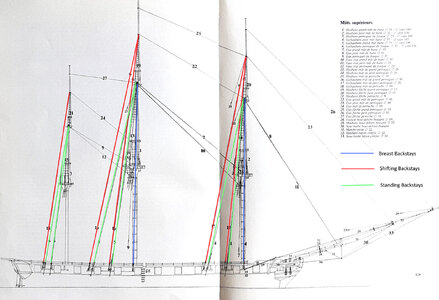Here's what James Lees, in his Masting and Rigging of English Ships of War, 1660-1865, has to say about both:
"Breast backstays had their upper and lower ends set up in the usual fashion [i.e., like the regular standing backstays], but according to models in the National Maritime Museum, very few English ships were fitted with them. The standing backstay seems to have served the same purpose by having the foremost backstay well forward along the channels. I have seen contemporary models - one of the 1719 Establishement and one of the 1733 Establishement - carrying a breast backstay, and then not found any again until 1839. When fitted, they ran abreast of the mast. Personally, I would not fit them unless they were shownon a painting or print of a model I intended to make, and then would only fit them after 1719....
"Shifting backstay size is given in the rigging tables, but this would not be seen generally as it was only used to give additional stay to the mast when sailing , and would be unrove in port or whenever it was thought fit. A pendant, half as long again as the burton pendant, was fitted however. A thimble was spliced into the lower end, while the upper end fitted the same as the burton pendant.
"Shifting backstay falls consisted of a long-tackle block hoooked in the thimble of the pendant, and a single block hooked in the fore channels or to an eyebolt in the deck."
Ted






